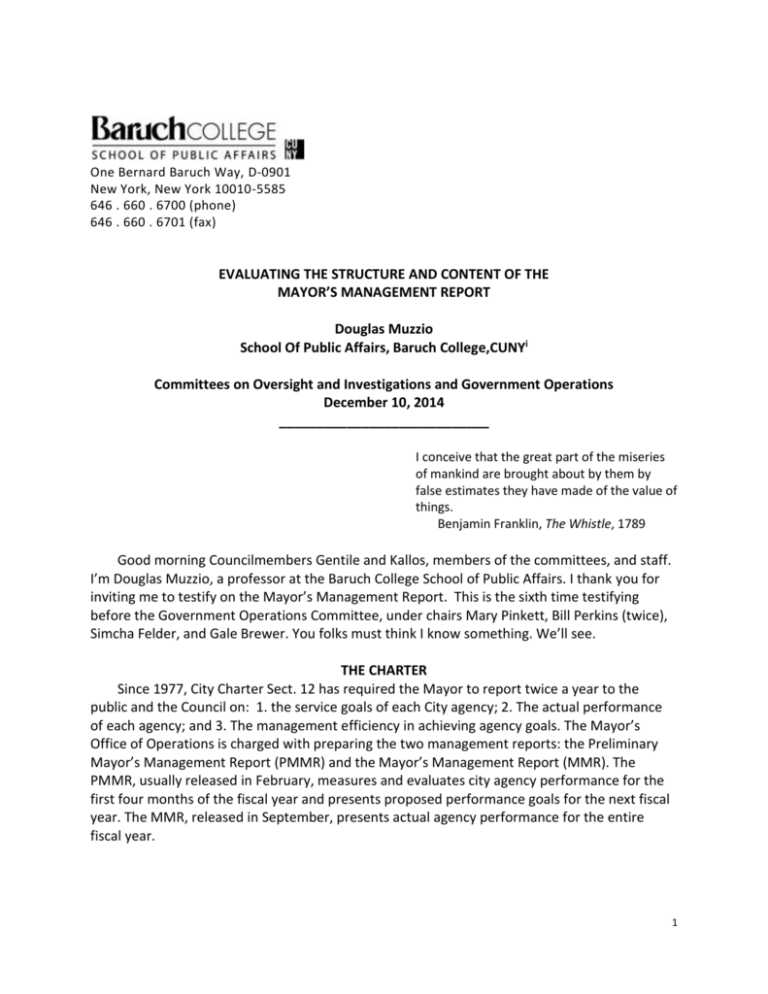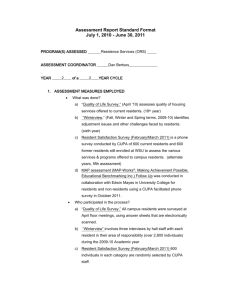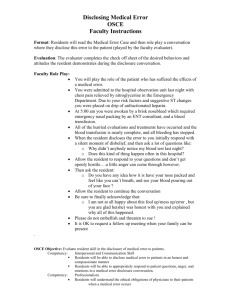12-10-14 D. Muzzio Testimony on MMR
advertisement

One Bernard Baruch Way, D-0901 New York, New York 10010-5585 646 . 660 . 6700 (phone) 646 . 660 . 6701 (fax) EVALUATING THE STRUCTURE AND CONTENT OF THE MAYOR’S MANAGEMENT REPORT Douglas Muzzio School Of Public Affairs, Baruch College,CUNYi Committees on Oversight and Investigations and Government Operations December 10, 2014 ____________________________ I conceive that the great part of the miseries of mankind are brought about by them by false estimates they have made of the value of things. Benjamin Franklin, The Whistle, 1789 Good morning Councilmembers Gentile and Kallos, members of the committees, and staff. I’m Douglas Muzzio, a professor at the Baruch College School of Public Affairs. I thank you for inviting me to testify on the Mayor’s Management Report. This is the sixth time testifying before the Government Operations Committee, under chairs Mary Pinkett, Bill Perkins (twice), Simcha Felder, and Gale Brewer. You folks must think I know something. We’ll see. THE CHARTER Since 1977, City Charter Sect. 12 has required the Mayor to report twice a year to the public and the Council on: 1. the service goals of each City agency; 2. The actual performance of each agency; and 3. The management efficiency in achieving agency goals. The Mayor’s Office of Operations is charged with preparing the two management reports: the Preliminary Mayor’s Management Report (PMMR) and the Mayor’s Management Report (MMR). The PMMR, usually released in February, measures and evaluates city agency performance for the first four months of the fiscal year and presents proposed performance goals for the next fiscal year. The MMR, released in September, presents actual agency performance for the entire fiscal year. 1 BLOOMBERG MMRs The first Bloomberg MMR released in Sept 2002 was a departure – and an improvement -from the Giuliani era. It was more concise, easier to navigate and use, Internet accessible and interactive, and provided somewhat more explicit agency mission statements, measurement indicators, and sources of measures. But the 2002 MMR -- and its predecessors and successors including the Sept. 2014 report, the second during the de Blasio administration, -- had several deficiencies, including lack of budget connections as mandated by the Charter absence of rigorously, frequently, and uniformly conducted customer surveys as agency and program outcome measures The 2002 MMR (its predecessors and its Bloomberg administration successors through 2011) also lacked narrative context; the documents had no overview, no introduction, no summary, no “vision” longitudinal and comparative data and measures coherent articulation of goals/objectives/targets within and across agencies In February 2012, the Mayor’s Office of Operations Director Elizabeth Weinstein initiated an MMR update, establishing the “Mayor’s Management Report Roundtable” to address those deficiencies, to improve the content, structure, presentation and public access. I was fortunate and honored to be invited to join the group. Office of Operations efforts were headed by Deputy Director Jeffrey Tryens and staffed by Operations and agency professionals. The effort was a model of public policy analysis and a paradigm of conceptualization, organization, and presentation. And hard work. The 2012 and 2013 MMRs were improvements over their predecessors in several ways: more logically structured, more clearly presented/visually engaging some introductory narrative context on agency function and performance illustrative linking of agency performance data to citywide and cross-agency initiatives (e.g. PLANYC) beginnings of comparative cross-city analysis wider use of five year trend data De BLASIO MMR The Sept 2014 MMR – the second of the de Blasio administration – reported on City agency performance from July 1, 2013 to June 30, 2014, spanning both the Bloomberg and de Blasio administrations. The report has retained and moved forward in some of areas noted above, providing narratives on key administration initiatives: Universal Pre-K, Vision Zero, Housing New York, the Young Men’s Initiative as well as climate change, including Sandy recovery metrics for these initiatives (Unfortunately the measures are output, rather than outcome and don’t include any customer/resident survey data) 2 “Focus on Equity” statements from each agency on efforts to promote “fair delivery and quality services to New Yorkers” which briefly summarize agency activities but do not explicitly address agency issues of equality/fairness and how to measure them. I presume that Operations is developing equality/inequality indicators to measure the nature and extent of inequality over time to assess agency/program/policy success in producing more equitable outcomes.ii agency performance measures tied to explicit and clearly articulated goals MAJOR DEFICIENCIES This testimony addresses the two major long-standing deficiencies of the MMR: the lack of resident surveying and the absence of linkage between budget and performance. There are certainly other areas of improvement not at all addressed here. My focus is on resident surveying as it has been in my previous Council testimonies. LACK OF RESIDENT SURVEYS The Sept 2014 MMR, like all its predecessors across six mayoral administrations, lacks comprehensive, uniform, recurring surveys of its residents as an integral feature of its performance assessment and reporting. Consensus on Value of Resident Surveys A consensus exists among government officials, management experts, and program analysts that government services must be “customer driven.” Government organizations should pay attention to residents’ perceptions and assessments of the quality of the services they provide. “The best way to encourage good performance is to measure it, and the best indicator of government performance is citizen satisfaction” (International City and County Managers Association) “Surveys of customers have begun to be perceived nationally, if not internationally, as a major source of evaluation feedback of public services and as an important component of public accountability” (Urban Institute) “It is important for reported performance to include measures of citizen and customer perceptions about the results of the service or program. Without this information against which to compare other, more quantitative measures of performance, a complete picture of results is not obtained” (Government Accounting Standards Board) Resident Survey Use in U.S. Resident surveys are used widely by U.S. municipalities to evaluate the impacts and quality of their services. FIGURE 1 Philadelphia, for instance, uses both agency data and resident survey data in its “Mayor’s Report on City Services,” that city’s equivalent of New York’s MMR. The beginning of the 3 Philadelphia 2004 report presents “Citizen Satisfaction Highlights,” including five-year trend data on satisfaction on select (13) municipal services. Resident surveys provide a perspective on municipal services not available from other sources. As noted by the Controller’s Office for the City and County of San Francisco, “One of the most direct ways to measure the outcomes of the City’s effort – that is, the extent to which services are having their desired efforts – is to ask the users of those services.” Municipal/county resident surveys have been/are variously conducted, located in different governmental offices, in mode of survey conduct, in sampling, and whether the survey data are employed by managers and policy-makers. FIGURE 2 Benefits of Resident Surveys Resident surveys concentrate on the outcomes or the results of government services – how satisfied people are with their schools and parks, how safe they feel in their neighborhoods. Most administrative measures – including those derived from survey dated -- focus on inputs and outputs. While these are certainly important for internal accountability, public accountability – what the public wants from government – centers on results. Additionally, resident surveys allow for the analysis of individual differences in how people use and experience city services – for example, difference by race, ethnicity, age, and gender. Most administrative measures of service quality cannot identify who uses and how they are affected by the service. In a study of what citizens want from local government performance reporting, the Government Accounting Standards Board found that outcomes and resident perceptions were the performance measures of most interest to the general public. The Independent Budget Office has recommended that the city ‘identify and report on results that matter to the public and reflect the way the public sees and uses city services.” Rigorously constructed and conducted and appropriately analyzed surveys give residents “voice,” enhancing the quality of governance. Resident surveys are possibly the most efficient, if not the only, way to obtain information on: constituents’ satisfaction with the quality of specific services and facilities, including the identification of problem areas facts such as the number and characteristics of users and non-users of various services (and the frequency and form of use) reasons why specific services/facilities are disliked or not used community needs assessment; identification of high priority but inadequate community services, potential demands for new services residents’ opinion on various community issues, including feelings of confidence or trust toward government and specific agencies/officials residents’ assessment of real policy options. Results provide guidance (but not mandates) for official action. 4 resident surveys can provide socio-economic and demographic data to complement/supplement other sources. Resident Surveys and Policy Resident surveys, as outcome data, can inform decision makers and managers throughout the policy process: • Policy formulation: Help public officials to determine what residents need, want, prefer, or demand; help make choices, set priorities, change practices • Policy implementation: Help public managers determine how best to deliver services. As long as respondents have some knowledge about an implementation issue, questions can concern projects, programs, procedures. • Policy evaluation: With service delivery, the consumer’s perception is the pertinent reality. Even the most efficient department is not doing its job well if residents are not satisfied with the various dimensions of department output – e.g. quality, timeliness, range, scope, accuracy, reliability, convenience, utility, prices. Previous NYC Resident Surveys, 2000, 2001, 2009 In 2000 and 2001, the Baruch College Survey Unit (I was co-director) conducted resident surveys for the New York City Council under then-Speaker Vallone, the data and reports of which were presented to the Committee on Government Operations. The first was a telephone survey of 2132 adult residents of the five boroughs of NYC who were contacted in English and Spanish between August 1 and August 28, 2000. The second was based on telephone interviews of 2020 adult New York City residents contacted between July 17 and August 28, 2001. Survey questions were designed to determine use patterns and satisfaction with a broad range of City services, as well as their views on the overall quality of life in the City and their confidence in City government, among other matters. The surveys were not continued by the newly-elected Speaker in 2002. Those reports are available. In 2009, the Bloomberg administration with Public Advocate Gotbaum conducted a citywide “customer” survey with serious conceptual and analytical flaws and not followed up. Nor incorporated, it seems, in any city performance measurement report/database. It was extensively, and clearly reported and presented on the website. www.nyc.gov/html/ops/html/data/feedback.shtml Customer Satisfaction in the MMR In 2012, only two agencies reported customer satisfaction in the PMMR – Department of Design and Construction and the 311 Customer Service Center. In 2014, the Office of Operations queried city agencies on how they collected and reported for MMR indicator “Number of agency customers surveyed for overall customer satisfaction.” [2014?]. Twentyfour agencies replied. Agency practices varied “significantly in all aspects of determining customer satisfaction iii levels.” Among the findings: 5 most MMR agencies do not collect customer satisfaction data that could reliably considered measures of satisfaction at either the goal or agency level agencies used a variety of survey modes – Web, mail, in person. None used telephone surveying. agency-designed and administered surveys predominated the universe of customers surveyed ranged from a small segment of an agency’s constituency to a significant percentage of all “customer” groups the amount in information requested varied considerably by agency the number of completed surveys also varies considerably by agency The 2014 MMR A common feature of each reporting agency is a section titled "Agency Customer Service". A subheading is titled "Customer Experience." This is not so; what is measured are agency outputs, not customer outcomes. The three standard agency “Customer Service” measures are: “E-mails routed and responded to in 14 days”; “Letters routed and responded to in 14 days”; “Completed customer request for interpretation.” A preliminary review of the Sept 2014 MMR found six agencies that report some form of customer data: Parks: “Respondents who rated parks acceptable for overall condition” 311: “Customer satisfaction index” [3 of 6 years] HRA: “Customer satisfaction rating for Public Health Insurance Program services ‘good’ or ‘excellent’ DoE: “Customers rating service good or better (%)(as applicable)” NYCHA: “Customers rating service good or better (%)(as applicable)” DoITT: “Rate of overall customer satisfaction” I was unable to locate (probably my fault) any discussion in the document or website of the universe sampled, sampling method, dates of conduct, method of contact, number of respondents contacted/interviewed, questionnaires/question wording and order, frequency of contact. This information may be publicly accessible at other City data portals. NO LINKAGE OF PERFORMANCE AND BUDGETS Since 1977, the City Charter has required the P/MMR to include for each agency “proposed performance goals and measures for the next fiscal year reflecting budgetary decisions made as of the date of submission of the preliminary budget [Chap 1, Sect 12(b)(2)] The Charter also requires that the P/MMR contains appendices: 1. Setting forth the relationship between these performance goals and measures and the appropriations contained in the preliminary budget 6 2. Indicating the relationship between the program performance goals included in the P/MMR and “the corresponding expenditures made pursuant to the adopted budget of the previous fiscal year” The Charter mandate has never been complied through six mayoralties: Beame, Koch, Dinkins, Giuliani, Bloomberg, and de Blasio. The Charter requires the P/MMR to relate performance measures to proposed budget appropriations so that the Council, its mandated recipient, can consider what agencies have accomplished or produced with the resources allocated, and the effect of budget proposals during the budget process. (See Citizens Budget Commission, "Managing for Results in New York City Government: A Review of Current Practices, Nov 2006, pp. 11-17.) RECOMMENDATIONS FOR OPERATIONS Linking MMR measures with agency budgets Represents substantial efforts, both technical and political. Analyses conducted by the Office of Operations for the MMR Roundtable examined option/avenues as well as significant operational and conceptual difficulties They will not happen this or next or the next after that. The Office of Operations professionals need the resources and the active support of the Mayor and the First Deputy Mayor, particularly in dealing with some City agencies. RECOMMENDATIONS FOR COUNCIL PASS LEGISLATION SIMILAR TO INTRO 370 (2005) WHICH CALLED FOR MANDATING THAT THE MAYOR’S MANAGEMENT REPORT INCLUDE CITIZEN SATISFACTION SURVEY RESPONSES Use by Council committees of MMR in Council budget – and other -- hearings 7 FIGURE 1: RESIDENT SURVEY USE IN MAJOR U.S. CITIES Hundreds of U.S. counties, cities, and other local governments survey their residents regularly. Of the twenty largest U.S. cities, eleven conduct resident satisfaction surveys regularly. 1. New York 2. Los Angeles 3. Chicago 4. Houston 5. Philadelphia 6. Phoenix 7. San Antonio 8. San Diego 9. Dallas 10. San Jose No* No No No Yes Yes Yes Yes Yes Yes 11. 12. 13. 14. 15. 16. 17. 18. 19. 20. Austin Indianapolis Jacksonville San Francisco Columbus Charlotte Fort Worth Detroit El Paso Memphis Yes No No Yes No** Yes*** No Yes Yes No *In 2000 and 2001, the New York City Council funded citywide resident satisfaction surveys. In 2009 citywide resident satisfaction survey was conducted by the Mayor’s Office of Operations and the New York City Public Advocate. ** The last publicly available survey appears to be 2002 but city regularly surveys residents on issues e.g. recycling. *** Mecklenburg County. Sources: 2013 U.S. Census update on city ranking, author analysis of surveying. 8 FIGURE 2: WHERE (WHEN), WHO, HOW, WHAT SELECT U.S. CITIES CONDUCTING RESIDENT SURVEYS; WHO CONDUCTS? HOW MANY? HOW? PERFORMANCE INDICATORS? Philadelphia (2004) independent pollster 1101 telephone yes Phoenix (2006) Independent pollster 700 telephone yes San Diego (2004) Independent pollster 600 telephone no Portland (2006) City Auditor 2742 mail yes Dallas (2006) National Citizen Survey (ICMA) 1657 mail yes San Jose (2006) independent pollster 1000 telephone yes San Francisco (2007) City Controller 3,685 by mail (73%), telephone (20%), Internet (7%) no Austin (2005) independent pollster 1126 by mail yes i E-mail: dmuzz@aol.com Work: 646.660.6781 ii CUNY’s Institute of State and Local Governance is producing such multi-variate equality/inequality indicators. Baruch Survey Research will be surveying New York adult residents. 9






